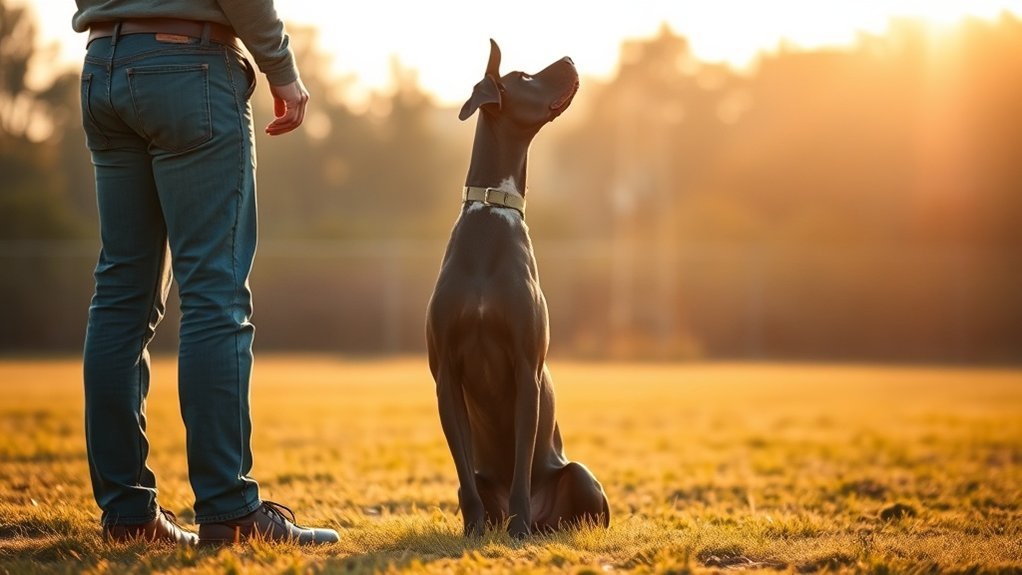Don’t Let My Size Fool You—I’m the Teacher’s Pet

Is a Great Dane Easy to Train
Soaking up everything you say. We love making you happy, which makes us great students when you teach us the right way.
Here’s a secret from the dog world: we respond way better to treats and praise than yelling. Seriously, if you start shouting, we’ll give you those sad puppy eyes and maybe hide behind the couch. We’re sensitive souls in big bodies! Keep those training sessions short – about 15 minutes is perfect. Any longer and we might start daydreaming about our next nap.
Now, about house training… okay, this might take a while. About 6 to 12 months, roughly. It’s not that we’re slow learners – we’re just, well, huge, so everything takes longer to figure out. Plus, when you gotta go, you REALLY gotta go when you’re our size!
The best part? When you’re patient and consistent with us, we’ll surprise you with how much we can learn. We might be giants, but we’re gentle ones who want to be your best buddy. Train us with love, and we’ll be the most loyal, well-behaved roommates you’ve ever had!
Understanding Great Dane Intelligence and Temperament for Training
First off, we’re pretty smart cookies! Not to brag, but we can figure things out pretty quickly when there’s something good in it for us (like treats or belly rubs). We love making you happy, which makes training way easier for both of us.
Just remember – we’re gentle giants who want nothing more than to be your best buddy. Our unique adaptive intelligence allows us to learn from our surroundings, which can be a big help during training.
Here’s the thing, though – we’re HUGE. I mean, when I’m standing on my back legs, I might be taller than you! This means training can get a little tricky. What works for your friend’s Chihuahua mightn’t work so well when you’ve got 150 pounds of excited Great Dane bouncing around.
Please, please, PLEASE don’t yell at us or use mean training methods. We’re sensitive souls, and harsh corrections make us sad and confused. We might even hide from you, and trust me, that’s the last thing either of us wants.
Positive training with lots of treats and praise? Now you’re speaking our language!
We’re great at solving problems and remembering stuff, but here’s a heads up – we stay “teenagers” way longer than smaller dogs. Early exposure to various environments helps reduce fear-based behaviors and aggression, making training even more effective! Regular training sessions keep our minds sharp and engaged, which is essential for our development.
Starting Early: Puppy Training and Socialization Essentials
Starting Early: What Us Great Dane Puppies Want You to Know About Training
Hey there, future human! I’m going to let you in on a secret – we Great Dane puppies are furry rockets that go from tiny 2-pound fluffballs to massive 100+ pound couch potatoes in just 18 months. That’s why you can’t wait around to teach us the rules of your house!
We need to start learning about the world when we’re just 8 weeks old. Trust me, everything seems HUGE and exciting when you’re a puppy, so the sooner you show us different people, weird noises, and new places, the better we’ll handle them when we’re the size of a miniature horse. Gentle training approaches are efficient with our sensitive nature.
| What We’re Learning | When We Need to Learn It |
|---|---|
| Where to go potty (hint: not your favorite rug) | 8-12 weeks |
| Cool tricks like “sit” and “stay” | 8-10 weeks |
| How to walk like a gentleman, not a sled dog | 10-14 weeks |
| Meeting strangers without jumping on them | 12-16 weeks |
| Advanced stuff that makes us look super smart | 16+ weeks |
Here’s what works best for us: keep things the same every day, give us treats when we’re good (we LOVE treats), and please be gentle when we mess up. We’re trying our best! Those daily 15-minute training sessions are perfect – any longer and our puppy brains turn to mush. But do this right, and you’ll have a confident, gentle giant who won’t accidentally knock over your grandmother. Remember, early training establishes good behaviors that set the tone for a lifetime of well-mannered interactions!
Effective Training Methods and Techniques for Large Breeds
First things first – forget about being all tough and bossy with us. That stuff doesn’t work, and honestly, it’s pretty silly when you think about it. I weigh more than most of you people, so trying to force me around is just going to end badly for everyone.
Plus, we Great Danes are gentle giants who want to make you happy. We can stand up to 32 inches tall at the shoulder, so being gentle is key to working with our size.
Here’s what works on us: TREATS! And not those tiny boring kibble pieces either. I’m talking about the good stuff – cheese, chicken, whatever makes my tail wag like crazy.
Throw in some belly rubs and a good game of fetch, and you’ve got my full attention.
Now about this leash thing – yeah, we need to learn that early. I don’t mean to drag you down the street, but sometimes I see an interesting squirrel and, well, physics happens.
When I’m full-grown, I can accidentally turn you into a human kite if I’m not trained properly. Start teaching me “heel” when I’m still small enough that you won’t need a chiropractor afterward.
Keep our training sessions short and sweet. My brain works great, but my attention span is about as long as a dog treat is tasty.
After five or ten minutes of learning, let me have a nap. We’ll both be happier that way. Also, don’t forget to focus on socialization early on, as this is crucial for helping me become a well-adjusted giant! Regular positive interactions with various people and environments will help me thrive.
The Importance of Consistency in Great Dane Training
Hey there, my favorite humans! Let me tell you something important from down here at knee level (well, okay, maybe chest level since I’m pretty tall). When you’re trying to teach me stuff, you need to be consistent. Trust me on this one – I’ve got the inside scoop!
See, we Great Danes are pretty smart cookies. And because we’re the size of miniature horses, we quickly figure out that we can use our size to get what we want. But here’s the thing – we WANT you to be the boss! We need you to prove you mean business every single day. Consistency helps build a strong bond between us, making training much more effective.
When you tell me to sit, make sure you always mean sit. Don’t say sit on Monday, but then let me get away with just standing there on Tuesday because you’re tired. That isn’t very clear! My brain works best when the rules stay the same. It’s like playing a video game where the controls keep changing – super frustrating!
And please, PLEASE give me my treats the second I do something right. Not five minutes later, when you remember, but right away. My attention span isn’t terrible, but I won’t connect “good dog” with sitting if you wait until after you finish your text message.
Oh, and here’s a big one – get your whole family on the same page! When Mom says “down” means lie down, but Dad says “down” means get off the couch, I’m going to be one confused pup. We Great Danes are sensitive souls, and mixed signals make us anxious.
I’d much rather have short, fun training sessions every day than one super long, boring session once a week. Think of it like eating – I’d rather have regular meals than feast once and starve the rest of the time! Keep it predictable, keep it positive, and I promise I’ll be the best gentle giant you’ve ever seen. Plus, remember that consistent feeding and bathroom schedules make a massive difference in my overall behavior and comfort during training!
House Training Challenges and Timeline Expectations
Woof! Let me tell you about house training from a Great Dane’s perspective—it’s like learning to park an 18-wheeler when everyone else is driving Mini Coopers!
First off, we Great Danes need way more time to figure this whole bathroom thing out. While those tiny dogs get it done in 4-6 months, we gentle giants need 6-12 months.
Here’s the thing about being our size: when we mess up, we mess up. I’m talking about accidents that look like someone dumped a bucket on your floor. My human neighbor’s Chihuahua makes what looks like a puddle from a leaky faucet.
Me? I create what looks like a small lake. Sorry, not sorry—that’s just physics! Proper socialization is key to helping us learn appropriate behaviors, including house training.
And don’t even get me started on timing. My digestive system is like a slow-moving freight train compared to those zippy little dogs. Food goes in, travels through what feels like miles of Great Dane plumbing, and comes out when it’s good and ready. This makes it super tricky for my humans to predict when I’ll need to go outside, which is why establishing regular feeding schedules can help create predictable routines. One minute I’m fine, the next minute I’m doing the “gotta go” dance by the door.
Timeline and Patience Requirements
Why My House Training Takes Forever (And It’s Not My Fault!)
Hey there, humans! Let me tell you something about us Great Danes – we’re pretty smart cookies. I figured out the whole “go potty outside” thing way faster than my Golden Retriever neighbor did.
But here’s the thing that might surprise you: even though my brain gets it, my body didn’t get the memo for like… forever.
You see, I’m a giant puppy in a horse-sized body. While my little Chihuahua friend down the street was fully house trained at 4 months old, I was still having “oops” moments until I was almost a year old!
And trust me, when a 120-pound Great Dane has an accident, it’s not exactly a tiny puddle you can clean up with one paper towel.
Here’s what’s going on with us gentle giants:
- My bladder is playing catch-up with the rest of me (I grew three sizes in like two months!)
- When I mess up, it’s basically like someone dumped a water bottle on your floor.
- My brain figured out the rules at 3 months, but my body was like “nah, we’ll catch up later”
- I was hoping you could stick to our schedule because everything takes me longer to master
Size-Related Training Complications
My Big Dog Problems (And Why My Humans Are Always Cleaning)
First off, when I have accidents in the house (hey, it happens!), It’s not like when my Chihuahua neighbor, Peanut, has an oopsie. When I mess up, it’s like a small lake appears on the kitchen floor. My poor humans had to buy this super-strong cleaner that comes in giant bottles, and they put these weird plastic mats everywhere. I heard Mom tell Dad they should have purchased stock in paper towels before they got me!
And don’t get me started on my crate situation. Remember how Goldilocks tried all those beds? Well, that’s me with crates! The first one was way too small – I looked like I was trying to fit into a shoebox. The second one was still too small. The third one is FINALLY just right, but it takes up half the living room. Dad jokes that we should just put a roof on it and call it a guest bedroom.
| My Daily Struggles | Why Size Matters |
|---|---|
| My crate | Looks like a small garage |
| Walking on a leash | I’m a furry bulldozer |
| Bathroom mistakes | Think “Great” Lake, not a puddle |
| Baby gates | I step over them like speed bumps |
Walking me is pretty funny too. When I see a squirrel and decide to chase it, my human suddenly becomes a kite! I weigh about as much as a motorcycle, so when I pull, things happen whether my humans want them to or not. They bought me this special harness that looks like it could tow a car.
Those little gates they put up to keep me in certain rooms? Please! I step right over them like they’re not even there. It’s like they built a fence for ants and expected an elephant to stay put. My humans finally gave up and bought gates that are taller than some people!
But you know what? Even though I cause big messes and big problems, I give even BIGGER love. And my humans wouldn’t trade me for all the easy-to-clean Chihuahuas in the world!
Exercise Requirements and Mental Stimulation Needs
You might think that because I’m the size of a miniature horse, I need to run marathons every day. But here’s the funny thing – I’m pretty chill! About 30 to 60 minutes of exercise daily is perfect for me. I’m more like a gentle giant who enjoys lovely walks around the neighborhood and some fun playtime in the yard.
Don’t get me wrong, I love a good game of fetch (even though I might accidentally knock over your lawn furniture with my enthusiasm).
But what gets my tail wagging is when you challenge my brain! I’m smarter than I look, and trust me, that’s saying something since I look pretty wise already.
Give me puzzle toys to figure out, teach me new tricks, or switch up our walking routes so I can sniff all the exciting new smells. When my brain gets a good workout, I’m much better at paying attention during training time.
Plus, I’m way less likely to do silly things like rearrange your living room with my giant paws or “redecorate” your shoes.
The secret is keeping both my body AND my brain busy. Do that, and you’ll have one happy, well-behaved Great Dane on your hands!
Moderate Exercise Needs
My Exercise Needs (From a Great Dane Who Knows Best!)
You might look at my massive paws and think, “This dog needs to run for hours!” But here’s the thing: I’m more of a “chill and stroll” kind of pup. My joints are still figuring out how to handle all this magnificence, especially when I’m young.
Think of me as a luxury car – I need regular maintenance, not drag racing!
Here’s what makes this Great Dane happy:
- Two lovely walks each day (20-30 minutes each) where we can sniff stuff and say hi to neighbors
- Gentle playtime that won’t turn my knees into creaky door hinges
- Swimming is awesome! I feel like a graceful whale instead of a clumsy giant
- No crazy jumping or high-impact stuff until I’m fully grown (that’s around 2 years old, in case you’re counting)
I promise this “take it easy” approach will keep me healthy and make training way more fun.
When my joints feel good, I’m a much better student! Plus, moderate exercise means more energy left over for essential activities like stealing your spot on the couch.
Mental Stimulation Benefits
Hey there, fellow humans! Let me tell you something – just because I’m a gentle giant doesn’t mean my brain is taking a nap all day.
Sure, I need my walks and playtime to keep these long legs moving, but my mind is like a supercomputer that needs some serious challenges too!
You know what’s awesome? When my humans give me puzzle toys that fit my enormous paws. I’m like a furry detective trying to figure out how to get those treats out.
It’s way better than chewing up the couch cushions (sorry about that, by the way – I was just SO bored).
My absolute favorite thing is when dinner becomes a treasure hunt. Instead of just wolfing down my kibble in two seconds, my humans hide it around the house or put it in special feeding toys.
I get to use my super-sniffer nose and feel like I’m on a mission. Plus, it stops me from inhaling my food like a vacuum cleaner.
Training sessions are pretty cool too, even though I sometimes pretend I don’t hear “sit” the first five times.
The truth is, I love learning new tricks and showing off my smarts. When my brain gets a good workout, I’m way better at listening and not knocking over the coffee table with my enthusiastic tail wags.
Trust me, a mentally tired Great Dane is a happy Great Dane – and happy humans too!
Final Thoughts
Woof! Let me tell you about training from a Great Dane’s perspective – it’s quite the adventure!
My humans think I’m a puzzle they can’t figure out. One week I learned “sit,” “stay,” and even “roll over” like I was born for the circus. But ask me not to drink from the toilet? That’s rocket science that takes months to master. What can I say – priorities!
I love learning new things because my humans get so excited when I do tricks. Their happy voices make my tail wag so hard it could power a small fan. But here’s the secret they don’t know: I’m pretty sensitive. When they use their disappointed voice, it makes me feel like a deflated balloon. So please, humans, keep it positive!
Now, about those “boundaries” you’re always talking about – I weigh 150 pounds and I know it! Sometimes I like to test if the couch rule still applies when I’m feeling extra cuddly. Spoiler alert: it always does, but a Great Dane’s gotta try!
The best part about being trained is meeting other dogs and people when I’m little. Trust me, socialization is way more fun when I’m puppy-sized instead of horse-sized. And those long walks? They’re not punishment – they’re the highlight of my day! A tired Great Dane is a good Great Dane, after all.
References
- https://vetslovepets.com.au/blogs/dog/great-dane-breed-guide
- https://www.about-great-danes.com/training-Great-Danes.html
- https://greatdanecare.com/great-dane-statistics-trends-analysis/
- https://a-z-animals.com/animals/great-dane/great-dane-facts/great-dane-progression/
- https://www.akc.org/expert-advice/puppy-information/how-to-train-a-great-dane-puppy/







21 Comments